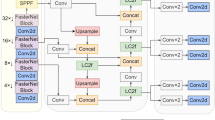Abstract
In the applications of water regime monitoring, incompleteness, and inaccuracy of sensor data may directly affect the reliability of acquired monitoring information. Based on the spatial and temporal correlation of water regime monitoring information, this paper addresses this issue and proposes an information fusion method to implement data rectification. An improved Back Propagation (BP) neural network is used to perform data fusion on the hardware platform of a stantion unit, which takes Field-Programmable Gate Array (FPGA) as the core component. In order to verify the effectiveness, five measurements including water level, discharge and velocity are selected from three different points in a water regime monitoring station. The simulation results show that this method can recitify random errors as well as gross errors significantly.
Similar content being viewed by others
References
P. Bernardara, E. Rocquigny, N. Goutal, et al. Uncertainty analysis in flood hazard assessment: hydrological and hydraulic calibration. Canadian Journal of Civil Engineering, 37(2010)7, 968–979.
Xi Chen. Yong-Qin David Chen, and Zhi-Cai Zhang. A numerical modeling system of the hydrological cycle for estimation of water fluxes in the Huaihe River plain region. Journal of Hydrometeorology, 8(2007)4, 702–714.
J. R. Koch and T. V. Freiberger. Autonomous real-time monitoring of hydrological environments. 30th Annual International Computer Software and Applications Conference, Chicago, USA, September 2006, 376–377.
Lin Zhigui, Xu Lizhong, Shen Zuyi, et al. Applying information integration in water environment monitoring. Automation in Water Resources and Hydrology, (2003)2, 1–7 (in Chinese). 林志贵, 徐立中, 沈祖怡, 等. 信息融合在水环境监侧中的应用. 水利水文自动化, (2003)2, 1–7.
P. J. Escamilla-Ambrosio and N. Mort, A hybrid Kalman filter-fuzzy logic architecture for mutisensor data fusion. IEEE International Symposium on Intelligent Control, Mexico City, Mexico, September 2001, 364–369.
Xu Lijia. Improvement of D-S theory in an information fusion system. Systems Engineering and Electronics, 26(2004)6, 717–720 (in Chinese). 许丽佳. D-S 理论在信息融合中的改进. 系统工程与电子技术, 26(2004)6, 717–720.
J. A. Stover, D. L. Hall, and R. E. Gibson. A fuzzy-logic architecture for autonomous multisensor data fusion. IEEE Transactions on Industrial Electronics, 43(1996)3, 403–410.
D. Mohamed and M. Zasadzinski. Data reconciliation in generalized linear dynamic systems. American Institute of Chemical Engineers Journal, 37(1991)2, 193–201.
A. Rakar and D. Juricic. Diagnostic reasoning under conflicting data: The application of the transferable belief model. Journal of Process Control, 12(2002)1, 55–67.
T. A. Patriciua and D. M. Himmelblau. Data rectification and gross error detection in a steady-state process via artificial neural networks. Industrial & Engineering Chemistry Research, 32(1993)12, 3020–3028.
Y. G. Du and D. Hodouin. Use of novel auto associative neural network for nonlinear steady-state data reconciliation. American Institute of Chemical Engineers Journal, 43(1997)7, 1785–1796.
R. W. Herschy. Hydrometry: Principles and Practice. 2nd Edition. NY, US, Wiley-Blackwell, 2003, 55–83.
R. M. Ham and I. Kostanic. Principles of Neurocomputing for Science and Engineering. NY, US, McGraw-Hill Companies, 2001.
A. Dinu, M. N. Cirstea, and S. E. Cristea. Direct neural-network hardware-implementation algorithm. IEEE Transactions on Industrial Electronics, 57(2010)5, 1845–1848.
R. G. Girones, R. C. Palero, J. C. Boluda, et al. FPGA implementation of a pipelined on-line back-propagation. Journal of VLSI Signal Processing Systems, 40(2005)2, 189–213.
A. R. Omondi and J. C. Rajapakse. FPGA Implementations of Neural Networks. Netherland, Springer, 2006.
S. Y. Kung and J. N. Hwang. Parallel architectures for artificial neural nets. IEEE International Conference on Neural Networks, San Diego, CA, USA, July 1988, 165–172.
Author information
Authors and Affiliations
Corresponding author
Additional information
Supported by the National Natural Science Foundation of China (No. 60774092, No. 60901003) and the Specialized Research Fund for the Doctoral Program of Higher Education (No. 20070294027)
Communication author: Wang Huibin, born in 1967, male, Ph.D., Professor.
About this article
Cite this article
Zhang, Z., Xu, L., Li, H.H. et al. An information fusion method for sensor data rectification. J. Electron.(China) 29, 148–157 (2012). https://doi.org/10.1007/s11767-012-0753-7
Received:
Revised:
Published:
Issue Date:
DOI: https://doi.org/10.1007/s11767-012-0753-7
Key words
- Information fusion
- Sensor data rectification
- Back Propagation (BP) neural network
- Field-Programmable Gate Array (FPGA)




